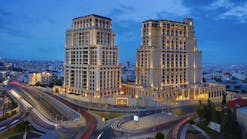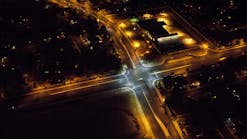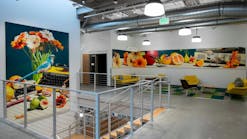RETAIL APPLICATIONS | LED retrofits deliver ROI for large retailers
For decades, the standard fluorescent bulb was the default lamp for retail lighting. This has remained true although alternatives have been available for more than fifty years. The light-emitting diode (LED) has and will provide a bright path forward for retailers since it greatly reduces energy consumption, offers lower maintenance costs, and is more ecologically friendly, with zero harmful ultraviolet emissions.
Adding LEDs via a retrofit requires a clearly developed scope of work that is matched with design, product, and installation plans. Retrofitting can be done in a variety of ways, from retrofit kits to existing troffers to full-scale fixture replacements that leverage the same wiring but potentially utilize fewer fixtures.
LED retrofits can minimize customer disruption, particularly when compared to full teardowns. In fact, it’s common for a retailer to close for business one day and open the next with LEDs installed. These considerations are especially important for large national retailers that want to deliver a consistent experience expeditiously while maximizing energy savings.
Top reasons for retailers to retrofit
With solid-state technology like LED, the materials that generate light are encased within a solid material, which translates into a light source with a much longer rated life (double) than those using non-solid-state technology, such as incandescent, halogen, or fluorescent bulbs. But the benefits for retail establishments don’t end there.
Improved quality of light. According to the U.S. Department of Energy, quality LEDs also offer instant-on performance, which is an appealing trait for some retailers. Additionally, they are easier to dim and utilize improved optics with better control over light distribution. Maintenance expenses are also reduced due to the aforementioned lifecycle of LED products. Improved light quality enhances the shopping experience, allowing stores to better contend with brick-and-mortar competitors as well as online retailers.
Improved environmental stewardship. Depending on the installation, retrofitting can reduce electricity bills by 40% to 60%. Furthermore, many utility companies offer rebates to incentivize retailers to transition to LED technology as doing so improves grid capacity. Finally, several states have already passed “clean lighting” laws to reduce both climate impacts and potential mercury pollution from fluorescent lighting, including California, Vermont, Hawaii, Colorado, Oregon, Maine, and Rhode Island.
As more retailers embrace LEDs to meet sustainability goals and improve customer experience, retrofit projects will become an appealing solution.
Pros and cons of retrofitting with LEDs
There are distinct advantages to a retrofit. It is generally more efficient to refresh a space with a retrofit solution than a teardown remodel. Teardowns inevitably lead to lost uptime, as the store typically needs to close while construction is in progress. Even if only part of the store needs to close, this will result in lost revenue and potentially frustrated customers.
Typically, a retrofit is quicker and more cost-effective to complete (especially when energy incentives are considered, which can offset the costs with faster ROI). It also reduces construction waste and may even lower the risk of encountering structural issues and hazardous waste in older buildings, making the process safer.
When comparing a retrofit to a remodel, retailers can expect 10% to 20% cost savings. That savings can jump to as much as 25% or more when compared to a new construction. If space does not need to be reconfigured to meet the needs of a new tenant, a retrofit may be the retailer’s preferred course of action versus new construction or teardown. Still, there are factors to consider when planning for a retail retrofit.
Lighting designers and installers must study the existing store design or layout. Given that LED sources are directional, they may induce glare due to installed surfaces, or spill light where it may not be most beneficial. Thus, some luminaires may need to be relocated to ensure even illumination, and perhaps their numbers reduced rather than planning a 1:1 replacement of existing fixtures.
Integrating LED lighting systems with existing infrastructure is also critical. For example, contractors will need to ensure that lighting management systems are compatible with new LED luminaires or account for interoperable alternatives.
National retailers with locations across multiple regions must also ensure lighting consistency from location to location. Ensuring consistent illumination across many locations means that contractors at every site need to adhere to the same design specifications.
Of course, the price of retrofitting multiple locations needs to be top of mind. The investment will need to factor in labor costs, materials, and potential lost sales if the location needs to be temporarily closed while work is completed. Calculating the ROI and positive impact on sustainability goals will be key to the overall decision-making process.
Ultimately, when comparing the differences in costs, labor, and operational downtime, retrofits often make more financial sense than teardowns or new construction.
Solutions and services targeted to retailers
Large national retailers that are considering retrofitting multiple stores with LEDs should look for a partner that has a similar scale and reach to help them manage and overcome many of the challenges that come with those projects. Some solutions providers will complete an energy audit at the start of every project, providing critical data for identifying the optimal solutions.
Completion time is also critical — as mentioned, retailers want to get the project finished quickly to minimize business disruption. National lighting solutions providers have the resources to get the right products to the right locations at the right time, which is still important even though we are past most of the pandemic-era supply chain issues. As an added bonus, large-scale partners are product agnostic, meaning they can help determine the optimal solution for each application or location.
Many parts of the country continue to face labor shortages and challenges. In addition to sourcing products and materials, the right partner can provide labor solutions that consolidate costs, reduce stress, and save time. Prefabricated and pre-kitted solutions enable workers to spend more time focused on critical tasks. Additionally, plug-and-play solutions allow specialized labor to be used more efficiently. Maintenance-free solutions are also available for customers that require them.
Finally, national solutions providers can provide additional services to help retailers manage large LED retrofit projects, such as assisting with state code requirements. They can provide photometric studies to help ensure that the required light levels are met. With detailed plans in hand and with knowledgeable project management partners, retailers can capitalize on the benefits of LED lighting while focusing on their business.
Sean R. Nacey
SEAN R. NACEY joined Wesco in 1996 and has held several positions of increasing responsibility. Most recently, Nacey was appointed to lead the EES U.S. Construction and Energy Solutions organization as senior VP and GM. Prior to his current assignment, Nacey led Wesco’s Integration Management Office (IMO) for the Anixter merger. He also served as director of corporate development for five years where he had responsibility for mergers and acquisitions. While in this role, he helped Wesco to successfully acquire and integrate 11 businesses with combined revenues in excess of $1.5 billion.
Nacey holds a bachelor’s degree in management information systems from Duquesne University in Pittsburgh.







